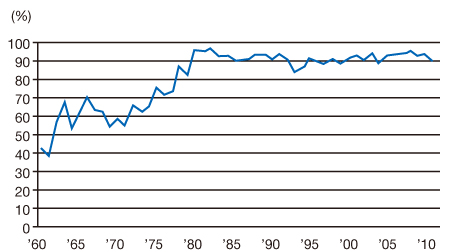J Korean Med Assoc.
2012 Feb;55(2):131-137. 10.5124/jkma.2012.55.2.131.
Emerging tasks of specialty certifying examination: educational measurement considerations
- Affiliations
-
- 1Department of Family Medicine, Hallym University College of Medicine, Chuncheon, Korea. inhong@paran.com
- KMID: 2192661
- DOI: http://doi.org/10.5124/jkma.2012.55.2.131
Abstract
- Medical specialty systems were launched in 1951 by the National Medical Services Law. The following year, the specialty certifying examination had implemented in the form of portfolio evaluation. A paper-and-pencil type examination was implemented in 1960, and the 55th examination was carried out in January 2012. Currently, 26 specialties are represented, and the overall pass rate is over 90%. The examination consists of a step 1 paper-and-pencil test and step 2 skills test. In the step 1 test, the test items are multiple choice questions and short answer questions. Clinical performance examination is partially applied to the step 2 test. To cope with changes in the social situation and the growth of medical services, developmental changes are needed in the specialty certifying examinations. Performance assessment is an alternative worth considering. CPX should be a major part of the skill test. A computer-based test should be introduced as soon as possible, and it could eventually be developed into an adaptive test.
Keyword
Figure
Cited by 1 articles
-
How can high stakes examination in Korean medical society be improved to the international level?
Sun Huh
J Korean Med Assoc. 2012;55(2):114-115. doi: 10.5124/jkma.2012.55.2.114.
Reference
-
1. National Medical Services Law. No. 221. 1951. 09. 25.
Article2. Korea Medical Association Examination Committee. 50 Years history of specialty certifying examination. 2008. Seoul: Korea Medical Association.
Article3. Ministry of Public Health and Social Welfare announcement no. 730. Gwanbo. 1960. (2593):1321.
Article4. Passing rate 70 percent. Euisasibo. 1960. 06. 02.
Article5. Mattick K, Bligh J. Teaching and assessing medical ethics: where are we now? J Med Ethics. 2006. 32:181–185.6. Palmer EJ, Devitt PG. Assessment of higher order cognitive skills in undergraduate education: modified essay or multiple choice questions? Research paper. BMC Med Educ. 2007. 7:49.7. Sibert L, Darmoni SJ, Dahamna B, Hellot MF, Weber J, Charlin B. On line clinical reasoning assessment with Script Concordance test in urology: results of a French pilot study. BMC Med Educ. 2006. 6:45.8. Schuwirth LW, van der Vleuten CP. ABC of learning and teaching in medicine: written assessment. BMJ. 2003. 326:643–645.9. Baik SK, Chae SH. Baik SK, Chae SH, editors. What is CAT. Computerized adaptive testing: a new technique for educational and psychological testing. 1998. Seoul: Wonmisa;23–40.
Article10. Wainer H. Wainer H, Dorans NJ, Eignor D, Flaugher R, Green BF, Mislevy RJ, Steinberg L, Thissen D, editors. Prologue. Computerized adaptive testing: a primer. 2000. 2nd ed. Mahwah: Lawrence Erlbaum Associates;2–22.
Article11. Lee YH. Introduction to an open source internet-based testing program for medical student examinations. J Educ Eval Health Prof. 2009. 6:4.
Article12. Huh S. Preparing the implementation of computerized adaptive testing for high-stakes examinations. J Educ Eval Health Prof. 2008. 5:1.
Article
- Full Text Links
- Actions
-
Cited
- CITED
-
- Close
- Share
- Similar articles
-
- Correlation of CPX Scores with the Scores on Written Multiple-Choice Examinations on the Certifying Examination for Family Medicine in 2009 to 2011
- Imperfect physician assistant and physical therapist admissions processes in the United States
- Current Tasks and Appropriate Tasks of Clinical Research Coordinators in Korea
- A Study on Certifying Systems for Clinical Laboratory Scientists
- Application of Computerized Adaptive Testing in Medical Education


